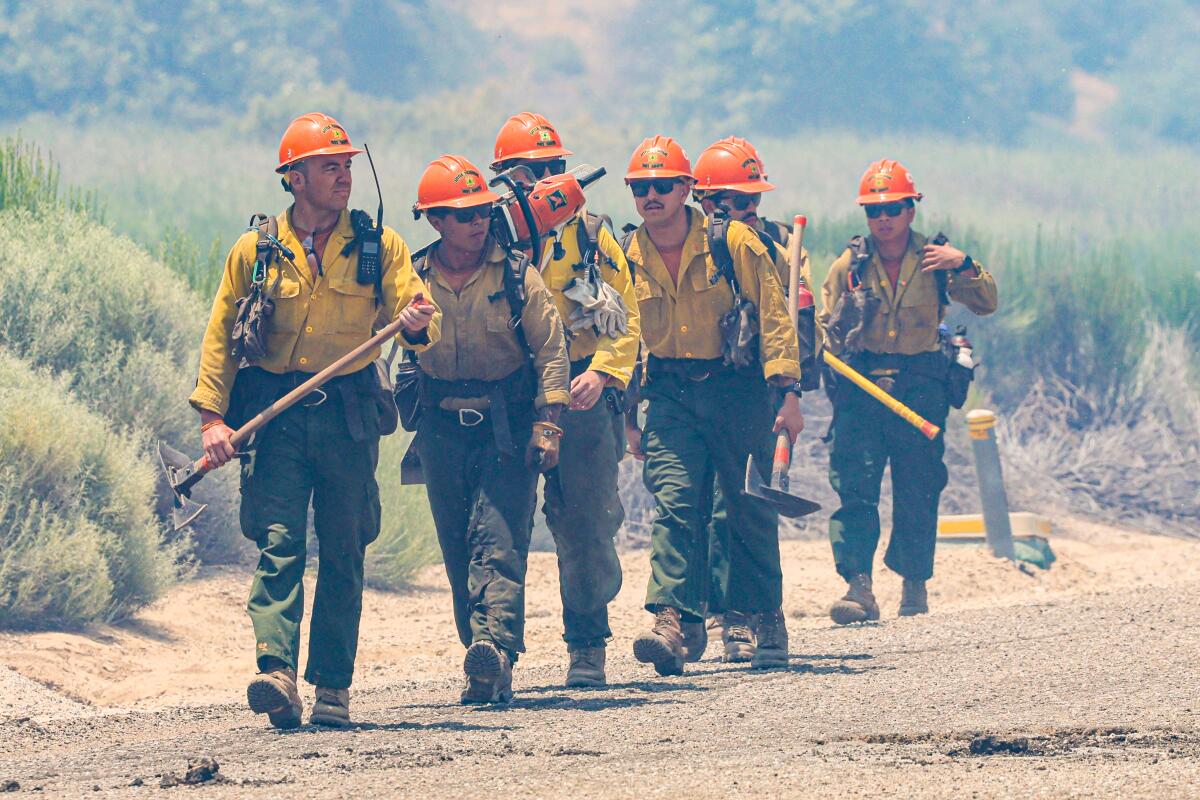Newsletter: How the fight against single-family zoning in L.A. is a battle for climate adaptation

Good morning. I’m Paul Thornton, and it is Saturday, June 22, 2024. Here’s what we’ve been doing in Opinion.
Los Angeles needs more housing, and the statistics on homelessness make that abundantly clear. Problem is, more than three-quarters of residential land in the city’s 469 square miles is zoned for single-family homes, putting the task of alleviating our housing shortage on a sliver of the city. As The Times’ editorial board noted this week, Los Angeles cannot be an affordable city if its leaders protect single-family zoning.
Two additional things should drive home the editorial’s call to increase density within Los Angeles: the wildfires raging in much of California right now, and the dreaded heat dome parked over Southern California that’s pushing temperatures dangerously high this weekend, especially in inland areas. Both calamities, though seemingly unrelated to the housing crisis, should emphasize the need to build more homes in your urban, single-family neighborhood.
First, the fires: Up the 5 Freeway from Los Angeles, the Post fire has burned about 16,000 acres since starting near Gorman, close to the Tejon Pass, on Sunday. Followers of housing policy in Southern California might know that area as adjacent to the site of the Centennial housing development, a proposed exurban residential community of 19,333 homes on land owned by Tejon Ranch Co. The project, pitched by backers as mitigating the state’s housing shortage, sits more than 70 miles from downtown Los Angeles on undeveloped land rated by the state as a high-fire danger zone, but the L.A. County Board of Supervisors approved the project in late 2018. Citing wildfire risk (and a host of other environmental concerns), an L.A. County judge last year threw out the county’s approval of Centennial, possibly dealing a fatal blow to the project.
New suburbs are built on such land (“greenfield” development) because doing so is cheaper and less of a regulatory hassle than getting approval for building housing in cities with extensive single-family zoning. But while it might make economic sense to build in a place like Tejon Ranch, far from the housing NIMBYs in L.A., it makes no environmental sense in an era of climate change and extreme wildfires. The Post fire burning near the site of 20,000 future homes ought to make frighteningly clear why it’s important to increase housing density within Los Angeles.
Second, extreme heat: Yes, it’s hot in Los Angeles right now, but much of the area sits close to the natural air conditioner of the Pacific Ocean. As a rule, the farther away from the coast you get, the greater the temperature extremes. Coastal areas are crowded in part because the weather is nice there — but it becomes less a matter of personal weather preference than one of safety as climate change worsens and extreme summer heat intensifies. As the editorial board noted in a separate piece this week, extreme heat is already the deadliest weather phenomenon in the state, and by mid-century more than 11,000 Californians could die every year if we continue with current rates of greenhouse gas emissions.
Affordable housing, then, is also an issue of climate justice. Building more places for people to live in coastal Los Angeles, where the danger posed by heat is less extreme than in “affordable” inland areas, could save lives as temperatures rise. People should be able to live where the weather won’t kill them.
With fires burning again, is California becoming uninsurable? Not really, says insurance industry advocate Rex Frazier, but only because the problems with the market in California are solvable. Allowing insurers to price homeowners’ policies according to projected payouts, instead of an average of previous ones, will help, he says. Jamie Court of Consumer Watchdog says the changes supported by Frazier and the state insurance commissioner will certainly raise rates, but they won’t necessarily get more Californians covered.
The great powers are itching for another nuclear arms race. Who will stop them? The Biden administration announced a “competitive” nuclear strategy that may result in the deployment of more weapons. This could be a major change in U.S. practice, yet the public hasn’t weighed in on nuclear policy in decades, leaving it up to a small group of strategists. “Everyday Americans can and should campaign against this dangerous nuclear expansion,” writes Steve Andreasen, who served on the National Security Council.
Enjoying this newsletter? Consider subscribing to the Los Angeles Times
Your support helps us deliver the news that matters most. Become a subscriber.
Why next week’s Biden-Trump faceoff is so novel — and what it means for future presidential debates. Voters have come to expect a certain set of circumstances for presidential debates: They follow a rigid format, happen late in the campaign (or after the candidates have at least been nominated) and have a neutral moderator. The idea is that this serves the public good. All that could change next week, says political science professor Seth Masket.
By keeping guns away from accused domestic abusers, the justices set an example for other courts. The Supreme Court’s common-sense ruling will save lives and make it more likely that other gun regulations will be allowed, writes UC Berkeley Law School Dean Erwin Chemerinsky. “Hundreds of challenges to these laws have been mounted in the last two years, and lower courts are split as to whether the regulations violate the 2nd Amendment. Now there is a strong basis for upholding them.”
More from this week in opinion
From our columnists
- Robin Abcarian: Los Angeles public schools will ban cellphones. What’s not to like?
- Jackie Calmes: Can the kowtowing to Trump get any worse?
From the Op-Ed desk
- Bird flu is a real threat. Here’s a way to fight it
- In “Parade,” Rachel Cusk persists in a relentless dismantling of the novel and the self
From the Editorial Board
- LAPD discipline ballot measure offers only minor reforms. City leaders must do more
- Shame on California lawmakers for killing fossil fuel divestment bill again
- Supreme Court’s commonsense gun rights ruling will keep Californians safer — for now
Letters to the Editor
- Yes, librarians know more about books than Huntington Beach’s MAGA mayor
- Venice isn’t getting the help it needs after two brutal attacks on residents
- Pesticides aren’t the only problem with marijuana
Stay in touch.
If you’ve made it this far, you’re the kind of reader who’d benefit from subscribing to our other newsletters and to The Times.
As always, you can share your feedback by emailing me at paul.thornton@latimes.com.
A cure for the common opinion
Get thought-provoking perspectives with our weekly newsletter.
You may occasionally receive promotional content from the Los Angeles Times.




